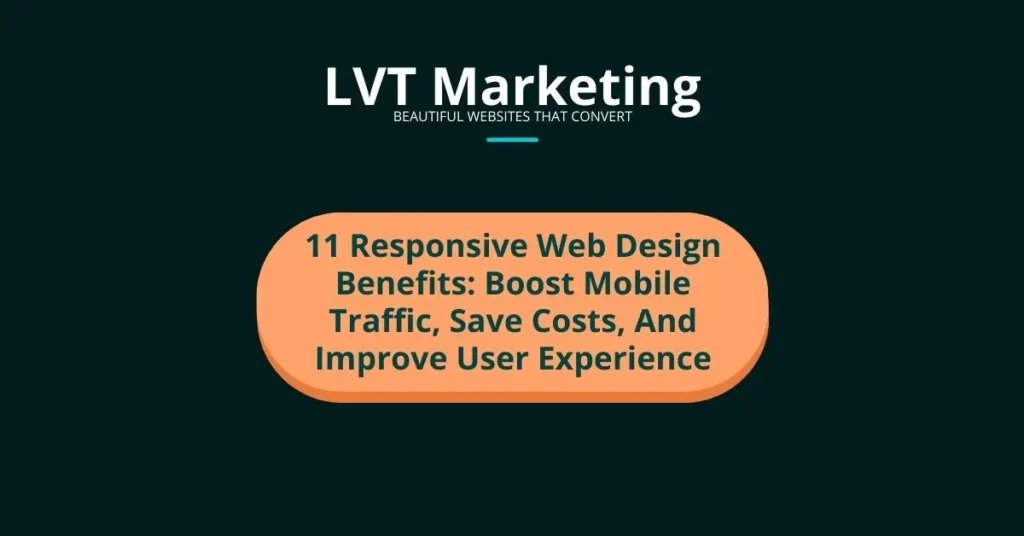
11 Responsive Web Design Benefits: Boost Mobile Traffic, Save Costs, And Improve User Experience
Are you getting bogged down with a tumble in mobile traffic, mounting website maintenance bills, and less-than-stellar user experience? We totally get where you’re coming from. Our research tidbit for the day: 80% of folks using the internet have a smartphone tucked away in their pockets or purses – so sprucing up your site to perform seamlessly on these devices isn’t just something nice to have; it’s downright essential.
This blog is ready to pull back the curtain on responsive web design, helping you gracefully leap over these obstacles. We’re serving up eleven fantastic benefits, which include pumping up your mobile traffic, slashing costs and stepping up user experience.
Excited yet? Well then, let’s jump right into it!
Key Takeaways
- Responsive web design increases mobile traffic by making it easy for users to access websites on their smartphones.
- It saves costs by eliminating the need to build separate websites for desktop and mobile use.
- Responsive design improves user experience by adapting to different screen sizes, resulting in faster loading times and reduced bounce rates.
- It boosts conversion rates by providing a seamless experience across devices, leading to more visitors turning into customers.
- Having a responsive website enhances SEO performance as search engines prioritize mobile-friendly sites with fast loading times.
Benefits of Responsive Web Design
Responsive web design offers a multitude of benefits, including increased mobile traffic, cost savings, improved user experience, higher conversion rates, and enhanced SEO performance.
Increased mobile traffic
More people now use their phones to go online. This is why your website must look good on a phone too. A site for mobiles makes it easy for these users to visit the web page. With this, more visitors will come to your site from their phones.
Our main goal is to get more people visiting our webpage, no matter what device they use!
Cost savings
We save money with a responsive web design. It costs less to make one website that works on all devices, than to build separate ones for desktop and mobile use. With just one site, you cut down on the work needed.
No more designing and updating two versions of your website.
Responsive design also lowers maintenance costs. Changes need to be made only once, not twice or more times across different sites. This frees up time for other important tasks in our business.
This is why smart businesses choose responsive designs – they’re easy on the pocket!
Improved user experience
Responsive design makes a big change for users. It allows sites to adapt to different screen sizes. This helps people use the site easily, no matter what device they have. They can find what they want fast and enjoy looking at your site.
Another good thing about responsive web design is quick loading times on all devices. Users don’t like waiting! Fast load times mean happy users who stick around longer on your website.
This reduces bounce rates and builds trust with visitors. Good user experience leads to repeat visits to your website and more business success.
Higher conversion rates
Responsive web design plays a crucial role in boosting conversion rates for businesses. By creating a user-friendly and seamless experienceacross different devices, responsive websites eliminate frustrations that may lead to visitors leaving without making a purchase or taking any action.
According to the Aberdeen Group, websites with responsive design saw a significant 10.9% increase in visitor to buyer conversion rates. This means that by adopting responsive web design practices, businesses have the opportunity to turn more of their website visitors into customers, ultimately improving profitability and success.
Enhanced SEO performance
Having a responsive web design is not only important for improving user experience but also for enhancing SEO performance. When your website is responsive, it adapts to different screen sizes and devices, making it more accessible to mobile users.
This accessibility plays a crucial role in achieving higher search rankings because search engines like Google prioritize mobile-friendly websites. Additionally, a responsive design leads to faster loading times, which is another factor that search engines take into consideration when determining rankings.
Furthermore, with a lower bounce rate thanks to an improved user experience on all devices, your website becomes more engaging and visible to both users and search engines alike. So by adopting a responsive web design approach, you can enjoy the benefits of increased visibility and better SEO performance.
The Importance of Mobile-Friendly Websites
Mobile-friendly websites are essential because of the growing usage of mobile devices, faster load times, lower bounce rates, and improved SEO performance.
Growing mobile usage
Mobile usage is on the rise, and it’s important for businesses to adapt to this trend. More and more people are using their mobile devices to access the internet, so having a mobile-friendly website is essential.
If your website is not optimized for mobile, you could be missing out on a significant amount of traffic. In fact, responsive web design can significantly boost mobile traffic to your site.
By ensuring that your website looks good and functions well on different screen sizes and devices, you can engage with customers who primarily use mobile devices and provide them with a better user experience.
Faster load times
Having a website that loads quickly is essential in today’s digital landscape. Research shows that even a one-second delay in page load time can have a significant impact on user engagement.
In fact, 47% of consumers expect a web page to load in under 2 seconds, and if it takes more than 3 seconds, 40% of users will leave the site altogether. This means that having faster load times can greatly improve your chances of retaining visitors and keeping them engaged with your website.
Not only that, but faster load times also contribute to boosting mobile traffic to your site. With the increasing use of mobile devices for browsing the internet, having a responsive website design ensures that your pages load quickly on smartphones and tablets, which can help attract more mobile users to your site.
Lower bounce rates
When users visit a website and quickly leave without exploring further, it’s called a bounce. Having a high bounce ratecan negatively impact your website’s performance. However, with responsive web design, you can reduce bounce rates and keep visitors engaged.
A responsive website adjusts its layout and content based on the screen size of the device being used. This means that whether someone is browsing on a desktop or a smartphone, they will have an optimized experience.
By providing a better user experience across different devices, responsive web design encourages visitors to stay longer and explore more pages on your site. Additionally, faster loading times and easy navigation contribute to lower bounce rates as well.
In fact, studies have shown that websites with responsive design tend to have lower bounce rates compared to non-responsive ones. So if you want to improve user engagement and lower your bounce rate, investing in responsive web design is definitely worth considering for your business.
Improved SEO
Implementing responsive web design can greatly improve the search engine optimization (SEO) of your website. With more and more people accessing the internet through mobile devices, having a mobile-friendly website is essential for ranking higher in search results.
Google considers mobile-friendliness as a key factor when determining search rankings. By adopting responsive web design, your website will be optimized for different screen sizes and devices, making it easier for search engines to crawl and index your content.
This can lead to increased visibility and organic traffic to your site, helping you reach a wider audience and attract more potential customers. Don’t miss out on the opportunity to boost your SEO by not implementing responsive web design!
Tips for Implementing Responsive Web Design
To implement responsive web design, prioritize content, optimize images, and utilize breakpoints for a seamless user experience across all devices. Learn more about these tips to create a website that drives mobile traffic and improves conversions.
Prioritizing content
One important aspect of responsive web design is prioritizing content. This means that you need to carefully consider what information and features are most important to your users. By prioritizing content, you can ensure that the most important elements are easily accessible on all devices. This can help improve the user experience and make it easier for visitors to find what they’re looking for. Some tips for prioritizing content include:
- Identify your key messages and goals: Determine what message you want to convey and what actions you want users to take on your website.
- Simplify navigation: Make sure your navigation menu is clear, concise, and easy to use on different screen sizes.
- Use clear headings and subheadings: Break up your content with headings and subheadings that clearly communicate the main topics.
- Optimize images: Use images that enhance the content and reduce file sizes for faster loading times.
- Display important information above the fold: Place essential information at the top of your pages so that users can see it without scrolling.
Optimizing images
Optimizing images is an important aspect of responsive web design. It helps to ensure faster loading times and a smoother user experienceacross different devices. Here are some tips for optimizing images:
- Compress and optimize images before uploading them to your website. This reduces file sizes and improves loading speed.
- Use the correct file format for each image. JPEG is best for photographs, while PNG is better for graphics with transparent backgrounds.
- Resize images appropriately for different screen sizes. Use CSS’s max – width property to ensure they display correctly on all devices.
- Consider using responsive image techniques, such as using srcset or picture elements, to serve the most appropriate image size based on the user’s device resolution.
- Test your website’s performance using tools like Google PageSpeed Insights or GTmetrix to identify any image-related issues that might be affecting load times.
Utilizing breakpoints
We use breakpoints in responsive web design. Breakpoints help us adjust a website’s layout based on different screen sizes. They allow fluid grids to change sizes and rearrange or hide content. By implementing breakpoints, we can enjoy benefits like increased mobile traffic, cost savings, and improved user experience. Plus, responsive web design ensures that websites load quickly without any distortions. We don’t need to manually resize content because breakpoints take care of it for us. When we consider different devices and properly implement breakpoints, we can overcome challenges and create awesome responsive websites.
- Breakpoints adapt a website’s layout to different screen sizes.
- Fluid grids adjust their sizes and rearrange or hide content based on breakpoints.
- Implementing breakpoints leads to benefits like increased mobile traffic, cost savings, and improved user experience.
- Responsive web design ensures quick loading without manual content resizing.
- Properly implementing breakpoints helps us overcome challenges while creating responsive websites.
Conclusion
In conclusion, responsive web design offers a multitude of benefits for business owners. It can boost mobile traffic, save costs, and greatly improve user experience. By implementing responsive design, businesses can reach more customers and provide an optimized browsing experience across all devices.
So don’t wait any longer – invest in responsive web design today to take your online presence to the next level!
FAQs
1. What are the benefits of responsive web design for my business?
Responsive web design benefits your business by increasing mobile traffic, saving costs, and improving user experience. It makes one single version of your website that looks good on all devices.
2. How does a responsive site boost mobile traffic?
A responsive site can boost mobile traffic as it allows users to access the web from any device easily. Mobile visitors find it easy to use which leads them to visit your website more often.
3. Can using a responsive web design save costs?
Yes! Having a single responsive site means you don’t have to spend money making separate desktop and mobile versions, or creating an additional stand-alone mobile site; this helps save costs.
4. What are some other advantages of adopting a responsive design?
Other advantages include better analytics data through services like Google Analytics, higher ranking in search results due to best practice policies, easier update processes, and consistent look and feel across all devices.
5. Does every online business need a responsive website?
With increasing mobile browsing trends worldwide, using a responsive web design has become increasingly important; thus having one is seen as best practice in both website design and development processes.
6. Is maintaining two versions of my website unhelpful?
Yes! Maintaining separate desktop and separate mobile websites requires more time than having just one single-site designed responsively making it tiresome and costly too.


